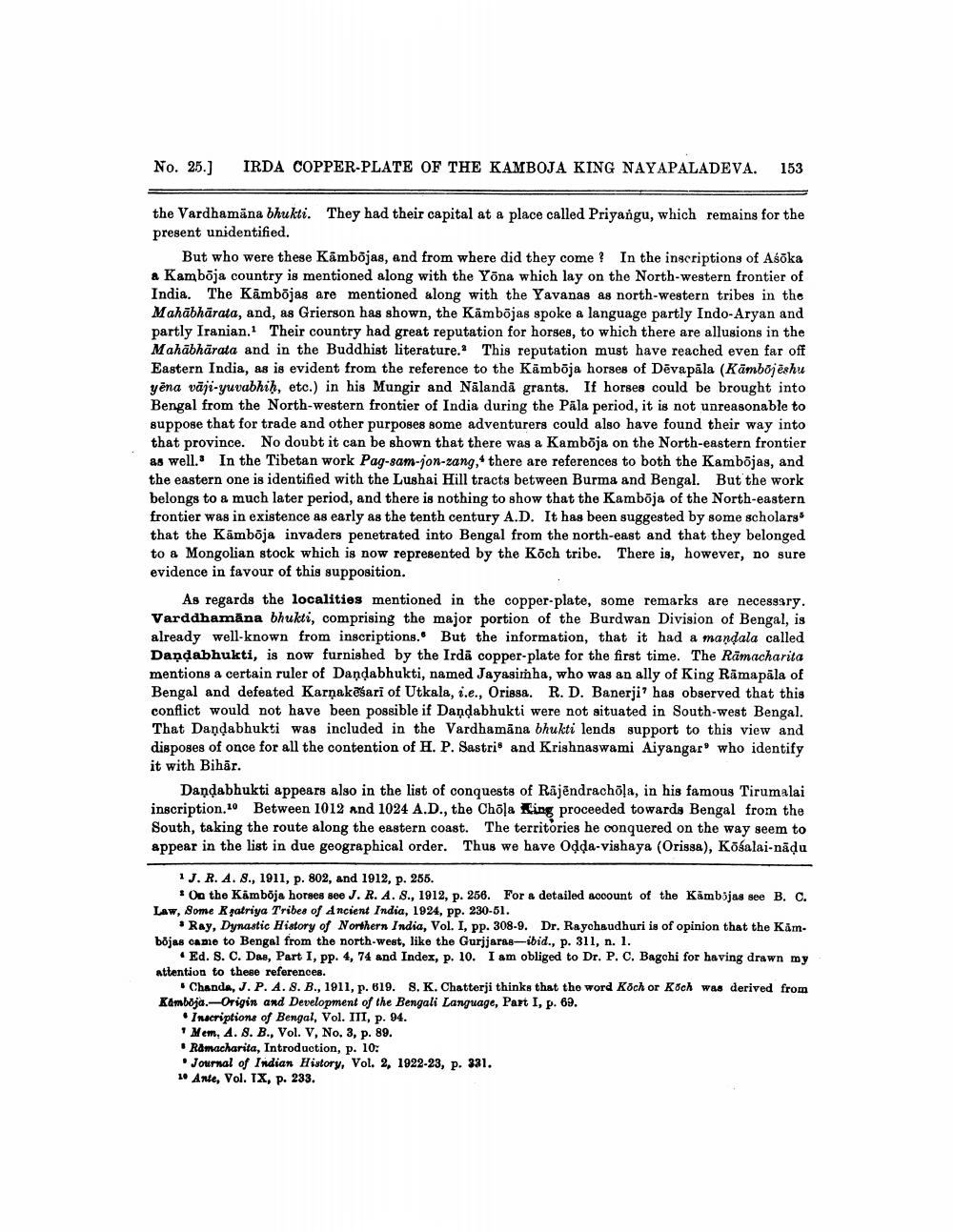________________
No. 25.)
IRDA COPPER-PLATE OF THE KAMBOJA KING NAYAPALADEVA. 153
the Vardhamana bhukti. They had their capital at a place called Priyangu, which remains for the present unidentified.
But who were these Kambojas, and from where did they come? In the inscriptions of Asöka a Kamboja country is mentioned along with the Yöna which lay on the North-western frontier of India. The Kambojas are mentioned along with the Yavanas as north-western tribes in the Mahābhārata, and, as Grierson has shown, the Kāmbõjas spoke a language partly Indo-Aryan and partly Iranian. Their country had great reputation for horses, to which there are allusions in the Mahābhārata and in the Buddhist literature. This reputation must have reached even far off Eastern India, as is evident from the reference to the Kämbõja horses of Dēvapāla (Kambojëshu yēna vāji-yuvabhiḥ, etc.) in his Mungir and Nālandā grants. If horses could be brought into Bengal from the North-western frontier of India during the Pala period, it is not unreasonable to suppose that for trade and other purposes some adventurers could also have found their way into that province. No doubt it can be shown that there was a Kamboja on the North-eastern frontier as well. In the Tibetan work Pag-sam-jon-zang," there are references to both the Kambojas, and the eastern one is identified with the Lushai Hill tracts between Burma and Bengal. But the work belongs to a much later period, and there is nothing to show that the Kamboja of the North-eastern frontier was in existence as early as the tenth century A.D. It has been suggested by some scholars that the Kamboja invaders penetrated into Bengal from the north-east and that they belonged to & Mongolian stock which is now represented by the Köch tribe. There is, however, no sure evidence in favour of this supposition.
As regards the localities mentioned in the copper-plate, some remarks are necessary. Varddhamana bhukti, comprising the major portion of the Burdwan Division of Bengal, is already well-known from inscriptions. But the information, that it had a mandala called Daņdabhukti, is now furnished by the Irdā copper-plate for the first time. The Ramacharita mentions a certain ruler of Dandabhukti, named Jayasimha, who was an ally of King Rāmapāla of Bengal and defeated Karņakasari of Utkala, i.e., Orissa. R. D. Banerji' has observed that this conflict would not have been possible if Daņdabhukti were not situated in South-west Bengal. That Dandabhukti was included in the Vardhamāna bhukti lends support to this view and disposes of once for all the contention of H. P. Sastri and Krishnagwami Aiyangar who identify it with Bihār.
Dandabhukti appears also in the list of conquests of Rajendrachöla, in his famous Tirumalai inscription.10 Between 1012 and 1024 A.D., the Chāļa king proceeded towards Bengal from the South, taking the route along the eastern coast. The territories he conquered on the way seem to appear in the list in due geographical order. Thus we have Odda-vishaya (Orissa), Kösalai-nādu
1 J. R. A. 8., 1911, p. 802, and 1912, p. 255.
. On the Kämböja horses see J. R. A. 8., 1912, p. 256. For a detailed account of the Kämb5jas see B. C. Law, Some patriya Tribes of Ancient India, 1924, pp. 230-51.
• Ray, Dynastic History of Northern India, Vol. I, pp. 308-9. Dr. Raychaudhuri is of opinion that the Kām. bojas came to Bengal from the north-West, like the Gurjjaras-ibid., p. 311, n. 1.
Ed. S. C. Das, Part I, pp. 4, 74 and Index, p. 10. I am obliged to Dr. P. C. Bagchi for having drawn my attention to these references.
Chanda, J. P. A. 8. B., 1911, p. 619. S. K. Chatterji thinks that the word Koch or Koch was derived from Kamboja.-Origin and Development of the Bengali Language, Part I, p. 69.
Inscriptions of Bengal, Vol. III, p. 94. Mem. A. 8. B., Vol. V, No. 3, p. 89. • Ramacharita, Introduction, p. 10:
Journal of Indian History, Vol. 2, 1922-23, p. 331. 1. Ante, Vol. IX. p. 233.




